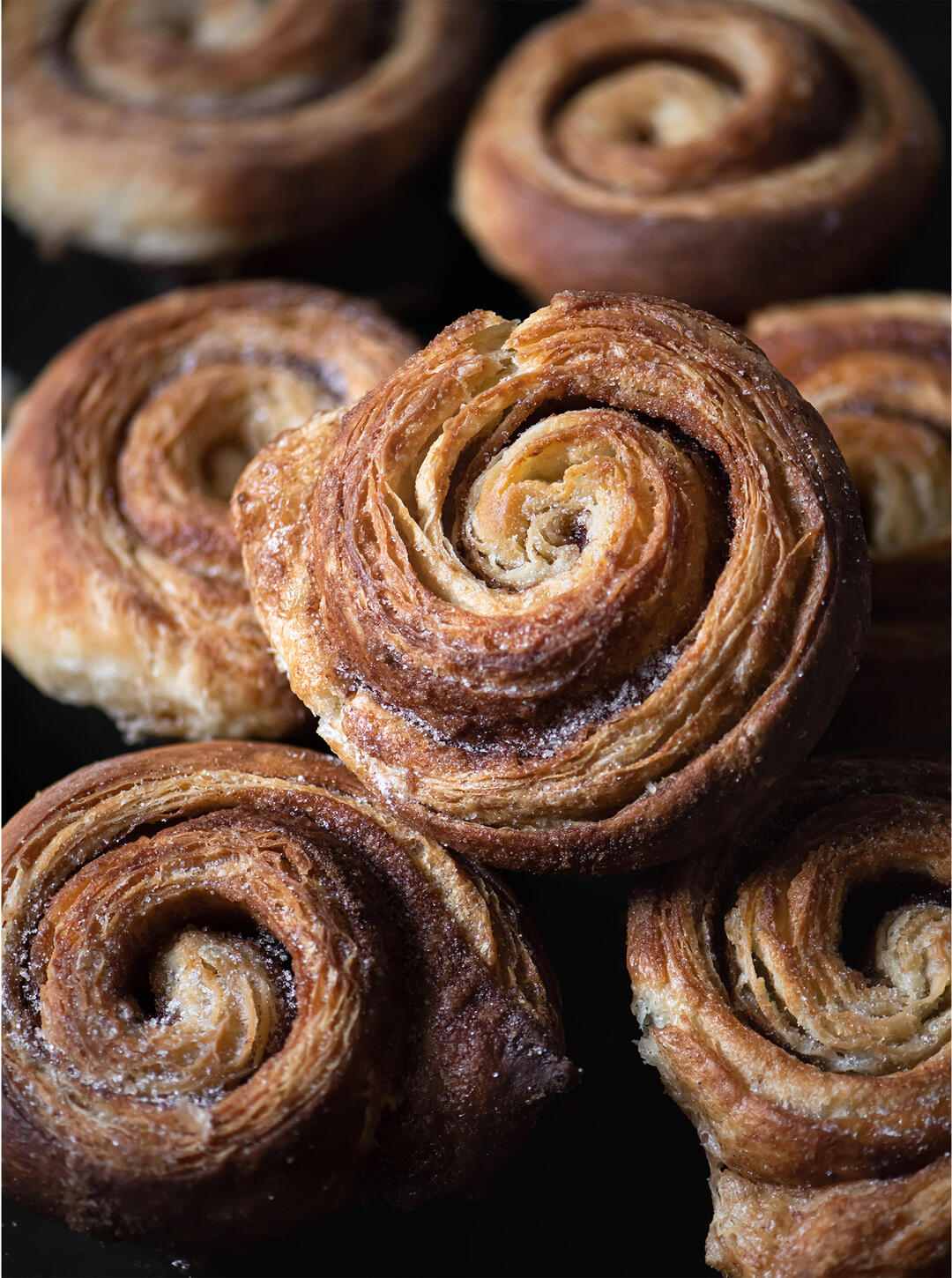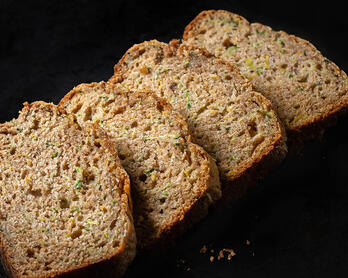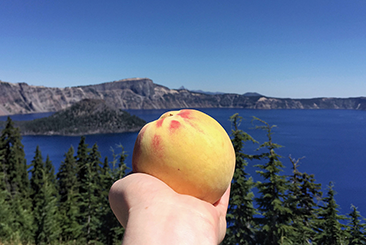Tartine Bakery's Morning Buns

Newsletter
Sign up at the bottom of this page for the free Chic Eats newsletter. It includes new recipes along with a grab bag of curated content that was interesting enough to share around the dinner table.
Classic
Morning buns are basically kouign amanns on steroids. The sugar mixture, spiked with orange zest and cinnamon, caramelizes to perfection on the bottom of the bun while the laminated dough becomes crackly on the outside and tender as a pillow on the inside. Elisabeth Pruiett was kind enough to share her morning bun recipe with the Internet so I'm posting it here with my own instructions.
I own the original Tartine (out of print) and Tartine Revisited which is an updated and expanded edition. Both books have recipes for croissant dough, offer helpful header notes, and measurements are listed in grams, cups, and ounces. That latter point is, in my humble opinion, essential if you're going to weigh ingredients which you should. Additional sweets I've written about include the Pumpkin Tea Cake and Zucchini & Orange Marmalade Bread. My Flaky All-butter Pie Dough is based on Tartine's ratios and has yet to fail me.
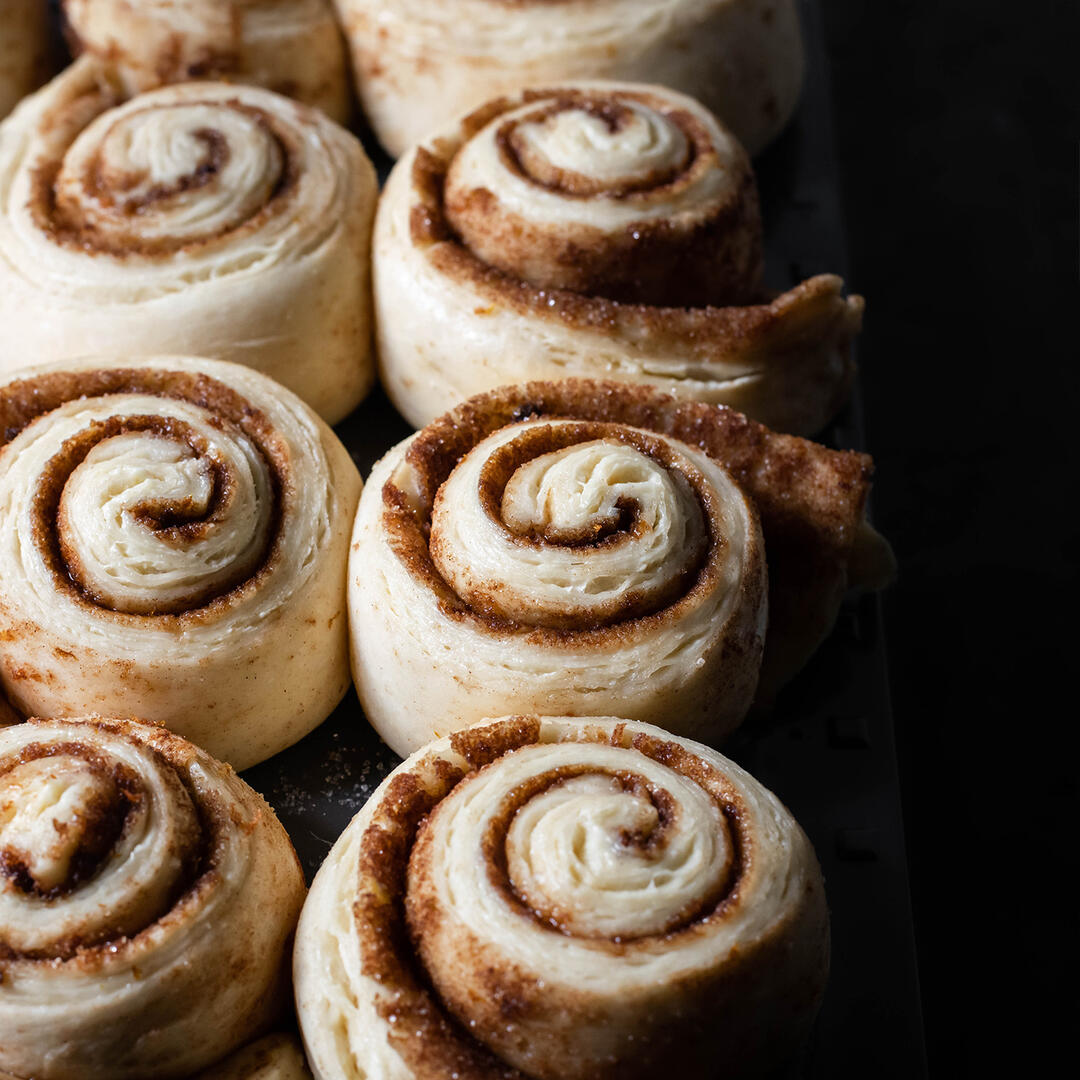
This dough baked up to look like the square buns at the top.
Recipe Tips
Morning Bun Size
The photos in this post are of two different bakes (notes included under each image), and though the sizes are quite different they were all flaky delights. The point is that you don't have to make enormous morning buns for them to be delicious. When I first tried this recipe, I was working with leftover croissant dough and the buns were small but still fantastic. I have used 2 1/2 pounds of dough for 12 buns and at other times upwards of 4 pounds. Size is more a matter of aesthetic than flavor so don't be too concerned about that. Even the scraps bake up nicely.
The recipe below uses 2 1/2 pounds of dough and produces 12 good-sized morning buns. The croissant dough recipe in Tartine makes 5 pounds of dough so cut the quantity in half. If you want to make all 5 pounds, the leftover croissant dough can be frozen for up to a week.
Whichever Way You Slice It
On the size note, the "Instructions" in this post suggest cutting the dough cylinder into (12) 1 1/2-inch pieces. If you want tall squared buns (pictured at the top), the dough will need to sit higher in the tin so that the buns proof into each other. Increase the size of the pieces to 2 1/2 to 2 3/4-inches. This will reduce the number of morning buns to about six unless you use more croissant dough.
Tin Placement
On the right side of the above proofing photo, note how the tail of the morning bun is on the outside. Ideally, you don't want to do that when the buns are larger. Try and face all the tails or ends inward so that the buns hold each other closed as they grow.
Proofing Time
Tartine's croissant recipe calls for 2-3 hours at approximately 75°F and I treat the morning buns the same way. It's best to avoid proofing the dough in an especially warm room as the butter layers will start to melt. A cooler proofing temperature just means the dough will take longer to increase in size which is fine.
The buns in the photos proofed at 74°F for about 3 hours. Take your time with this step since properly proofed dough is your best insurance against having the butter leak out.
Videos
- I have watched this video of Chad Robertson making morning buns several times. It's what made me realize that the dough has to be cut into larger pieces to get the square look.
- Tartine Bakery recently posted an IGTV video of their morning bun process. Interestingly, they don't seem to use brown sugar anymore.
Tartine Revisited
The new cookbook, Tartine Revisited, came out and the morning bun recipe has changed since it was originally posted online. A couple of notes:
- The orange zest quantity in the new cookbook is 55 grams or 1/4 cup. 55 grams of zest for 12 buns works out to about 1 teaspoon of zest per bun which seems like a lot. I only use 8-10 grams (total) as per the recipe posted years ago and the orange flavor is plenty pronounced.
- The cinnamon has been reduced from 2 tablespoons to 1 tablespoon in Tartine Revisited. The flavors are nicely balanced with 2 tablespoons so I plan to stick with that.

Citrus at Polito Family Farms - Santa Monica Farmers Market
Farmers | Artisans
I make an effort to source my food from California artisans with a special focus on the Santa Monica Farmers Market. Below is a list of the folks who contributed to this dish.
- Polito Family Farms / Valencia Oranges
- Central Milling (Sonoma) / Organic Beehive Flour
Tools
- Digital Thermometer - I own three Thermapen digital thermometers and have distributed them between my home, the Airstream, and my mother-in-law's house. They're nimble, easy to clean, and the probe is the perfect cake and quickbread tester. I reach for it often, especially when making croissant dough or working with yeast.
- OXO Scale - I highly recommend weighing your ingredients if you are going to the effort of making laminated dough. Generally speaking, it's good practice to use a scale when baking. There are two scales in my kitchen. The workhorse is an OXO model that I purchased over 10 years ago and only recently had to replace. RIP scale #1. It's a sturdy cooking companion that repeatedly gets covered in flour, sauce, or whatever else is flying around the kitchen.
- Pastry Brush - I use a small pastry brush for the tins and a large one for the dough. One tip - Though these are dishwasher safe, I've found the silicone picks up off flavors when cleaned that way. Hand washing is best.
- Fine Zester
- Fine Mesh Strainer (for sifting)
- Muffin Pan
- Baking Sheet
- Cooling Rack
- Aluminum Foil
- Parchment Paper
My Favorite Cooking Tools spotlights the kitchen equipment I have owned and used for years.
Ingredients (approximately 12 Morning Buns)
Note: As mentioned under "Recipe Tips", the Tartine croissant recipe yields 5 lbs of dough which makes 12 monster morning buns with some dough left over. This recipe uses 2 1/2 pounds of dough to make 12 good-sized morning buns. Size doesn't make them any more or less delicious, it's just a matter of personal preference.
- 2 1/2 pounds Tartine croissant dough Note: Cut the cookbook's quantity in half.
- 1/2 cup (3 1/2 oz/100 grams) brown sugar Note: I have started using 50 grams muscovado sugar and 50 grams dark brown sugar. Using all dark brown sugar definitely works.
- 1/2 cup (3 1/2 oz/100 grams) granulated white sugar
- Finely grated zest of 2-3 medium oranges (2 teaspoons or 8 grams)
- 2 tablespoons ground cinnamon
- 1/4 teaspoon Diamond kosher salt
- 4 ounces unsalted butter, melted and cooled
- Extra granulated white sugar for coating muffin tins and dusting the finished buns
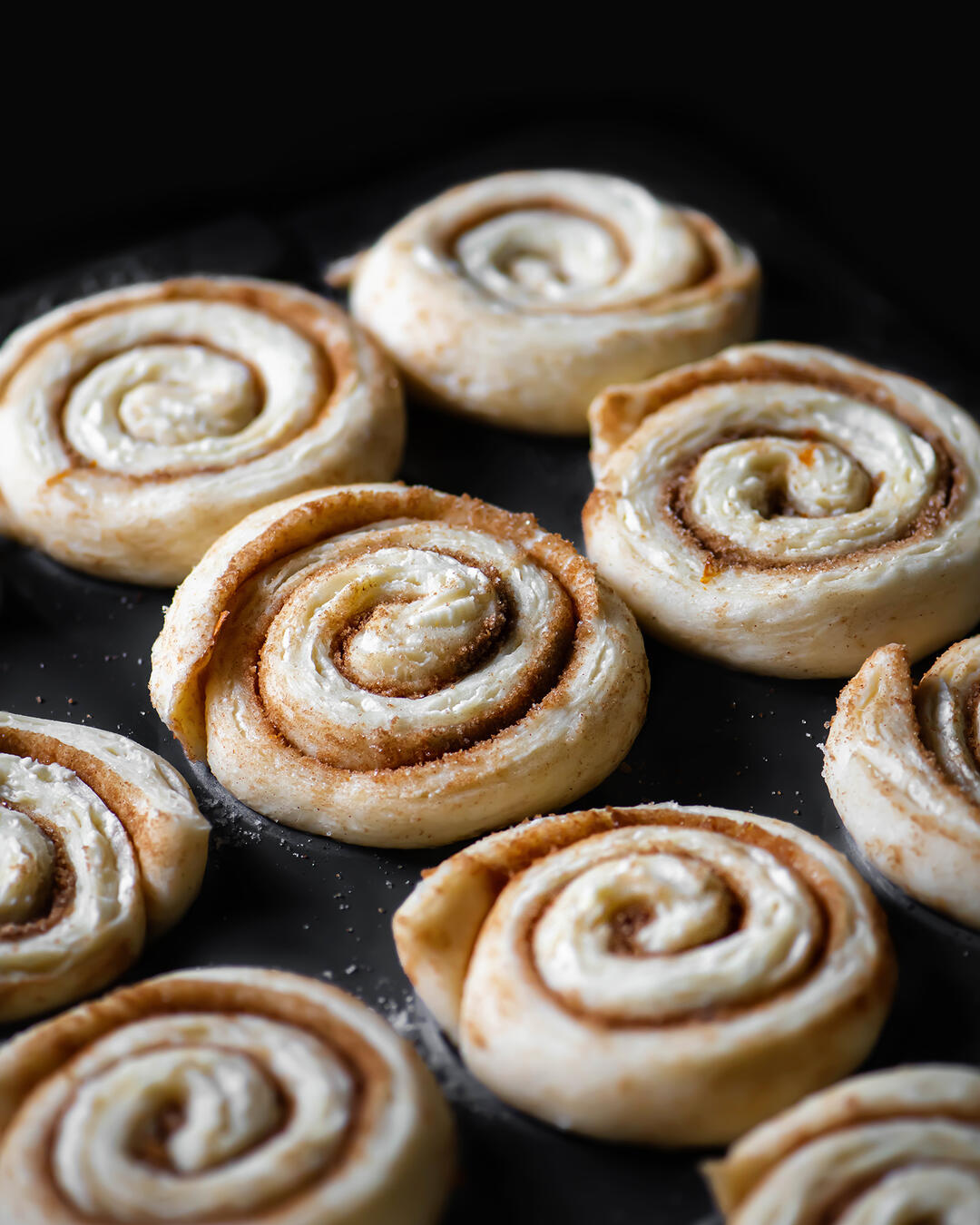
This dough baked up to look like the round buns at the bottom.
Instructions
Prep
- Combine the white sugar, brown sugar, cinnamon, and salt. Using a fork, mix everything together to ensure that the brown sugar doesn't have any lumps. Add the orange zest and mix thoroughly to distribute and release some of the oils. Set aside.
- Melt the butter.
- Brush the tins generously with some of the melted butter, sprinkle the sides and bottom of each with about a teaspoon of granulated sugar, tipping and tapping the pan to distribute. Turn the pan over and tap to remove any excess.
- I don't have a long ruler so I mark off 19 (left to right along the counter)x12 with painter's tape. It's helpful in terms of keeping the dough centered and rolling it evenly.
Roll & Cut
Note: Your butter should be room temperature or thereabouts. It's best to not put hot butter on the dough.
- Remove the chilled dough from the refrigerator and let it sit at room temperature to acclimate. If the dough is too cold, it may crack when you try to roll it.
- Roll the 2 1/2 pounds of croissant dough into a 19x10 rectangle which is about 3/8-inch thick. The long side should be in front of you.
- Brush the rectangle generously with 2 ounces of melted butter. You want enough butter so that the sugar adheres - you may not use all of it.
- Spread the sugar mixture evenly over the dough so that it's 1/8-inch thick.
- Starting on the long side, roll the dough into a snug cylinder.
- With a very sharp knife, cut the cylinder into 1 1/2-inch pieces. Note: See "Recipe Tips" for additional notes on size.
- Put each piece into a muffin tin with the cut or swirl side up.
Proof & Bake
- Proof for 2 1/2-3 hours at around 74-75°F. If it's cooler in the room that's fine, but if it's too warm the butter layers will start to melt. The size should increase to about 1 1/2 times the original. Note: As mentioned under "Recipe Tips", properly proofing the dough is your best insurance against leaky croissant dough.
- Move your oven rack to the middle position and preheat to 400°F.
- Place the muffin tin on a foil-lined baking sheet to catch drips then transfer to the oven. Immediately turn the heat down to 375°F.
- Set two timers, one for 20 minutes and one for 45. Bake for 45-55 minutes or until deep golden brown, turning the pan 180° after 20 minutes.
- Place a piece of foil on the counter and then a piece of parchment on top of that. Grab a wire cooling rack and set aside.
- As soon as the buns come out of the oven, carefully remove them from the muffin pan and place on the wire rack. Lay them on their side so that the caramel bottom doesn't stick. Let the buns cool for a couple of minutes.
- On the parchment lined foil, you can gently roll the buns in sugar, or, simply dust the entire morning bun using a mesh strainer for a lighter coating . Note: I prefer a dusting since this recipe has plenty of sugar in it.
- Let the morning buns cool slightly and then eat warm or at room temperature.
Storage / Make Ahead
Morning buns are best eaten the day they're made. That being said, there were two of us and a pile of morning buns so our stomachs were outnumbered. Below are a few different storage methods.
- Baked Buns (Counter) - I left two morning buns in a Ziploc bag overnight and then refreshed them in the oven at 350°F until warm and crisped. The flavor and texture held up very well.
- Baked Buns (Freezer) - The other option is to freeze the morning buns shortly after they have cooled completely. To reheat, leave them on the counter to defrost, then refresh in an oven at 350°F until warm. This works very well.
- Croissant Dough (Freezer) - The Tartine croissant dough can be frozen up to a week in advance. Simply transfer it to the refrigerator the night before you want to roll, proof, and bake.
Newsletter
Sign up at the bottom of this page for the free Chic Eats newsletter. It includes new recipes along with a grab bag of curated content that was interesting enough to share around the dinner table.
